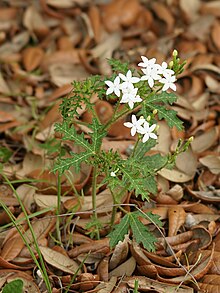
Urtica dioica, often known as common nettle, burn nettle, stinging nettle or nettle leaf, or just a nettle or stinger, is a herbaceous perennial flowering plant in the family Urticaceae. Originally native to Europe, much of temperate Asia and western North Africa, it is now found worldwide. The species is divided into six subspecies, five of which have many hollow stinging hairs called trichomes on the leaves and stems, which act like hypodermic needles, injecting histamine and other chemicals that produce a stinging sensation upon contact.
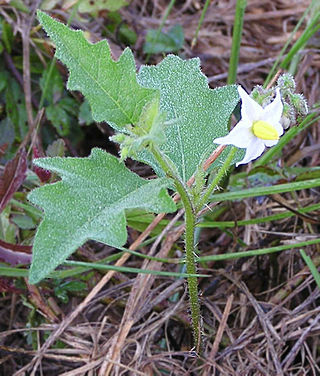
Solanum carolinense, the Carolina horsenettle, is not a true nettle, but a member of the Solanaceae, or nightshade family. It is a perennial herbaceous plant, native to the southeastern United States, though its range has expanded throughout much of temperate North America. The plant is an invasive in parts of Europe, Asia, Africa and Australia. The stem and undersides of larger leaf veins are covered with prickles.

Urtica ferox, commonly known as tree nettle and, in Māori, ongaonga, taraonga, taraongaonga, оr okaoka, is a species of nettle endemic to New Zealand. Unlike the other species in the genus Urtica found in New Zealand, all of which are herbaceous, ongaonga is a large woody shrub that can grow to a height of 3 m (9.8 ft), with the base of the stem reaching 12 cm (4.7 in) in thickness. It has large spines that can result in a painful sting that lasts several days.

Solanum elaeagnifolium, the silverleaf nightshade or silver-leaved nightshade, is a species of plant in the nightshade family native to North and South America. It is common in parts of southwestern USA, and sometimes weed of western North America. Other common names include prairie berry, silverleaf nettle, white horsenettle or silver nightshade. In South Africa it is known as silver-leaf bitter-apple or satansbos. More ambiguous names include "bull-nettle", "horsenettle" and the Spanish "trompillo".

Dendrocnide moroides, commonly known in Australia as the stinging tree, stinging bush, or gympie-gympie, is a plant in the nettle family Urticaceae found in rainforest areas of Malesia and Australia. It is notorious for its extremely painful and long-lasting sting. Indeed, it is sometimes referred to as the suicide plant because its sting is so misery-inducing that it has been said to cause suicides. The common name gympie-gympie comes from the language of the indigenous Gubbi Gubbi people of south-eastern Queensland.
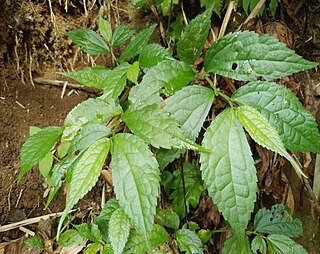
Pilea pumila, commonly known as clearweed, Canadian clearweed, coolwort or richweed, is an herbaceous plant in the nettle family (Urticaceae). It is native to Asia and eastern North America, where it is broadly distributed.

Eucnide urens, also known as desert rock nettle or desert stingbush, is a shrub which is native to desert areas in California, Arizona, Utah, Southern Nevada, and Baja California. Other common names are velcro plant and vegetable velcro.
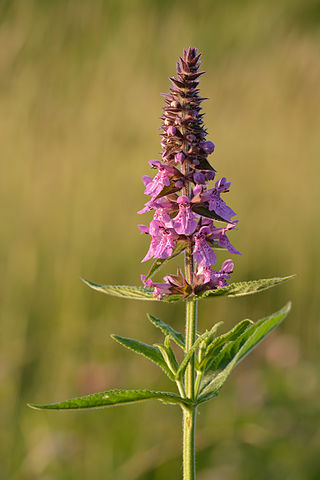
Stachys palustris, commonly known as marsh woundwort, marsh betony, clown's woundwort, clown's heal-all, marsh hedgenettle, or hedge-nettle, is an edible perennial grassland herb growing to 80 centimeters tall. It is native to parts of Eurasia but has been introduced to North America. The species epithet palustris is Latin for "of the marsh" and indicates its common habitat.

Euphorbia corollata is an herbaceous perennial plant in the family Euphorbiaceae that is native to North America. A common name for the species is flowering spurge. It has a milky sap that can cause skin and eye irritation in some people. It grows up to 1 m (3 ft) tall, with smooth stems and light green leaves arranged alternately or in whorls. Leaves are about 10 mm wide and 75 mm (3 in) long. Each stem terminates in a panicle 20 to 25 mm across. Flowers are about 6 mm across and consist of one pistillate and several staminate flowers surrounded by five white bracts - not petals but formed from the involucre at the base of the flowers. Flowering spurge blooms from June to September.
Bullnettle is a common name for several plants and may refer to:
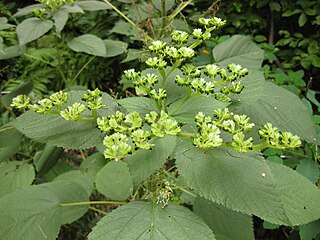
Laportea canadensis, commonly called Canada nettle or wood-nettle, is an annual or perennial herbaceous plant of the nettle family Urticaceae, native to eastern and central North America. It is found growing in open woods with moist rich soils and along streams and in drainages.

Galeopsis bifida is an annual plant native to Europe and Asia but now found in Canada and the northeastern, midwestern parts of the United States. It has many common names such as bifid hemp-nettle, split-lip hemp-nettle, common hemp-nettle, and large-flowered hemp-nettle. The genus name means weasel-like, referring to the corolla of the flower. It is often confused with other species of Lamiaceae such as Mentha arvensis, Dracocephalum parviflorum and Stachys pilosa.
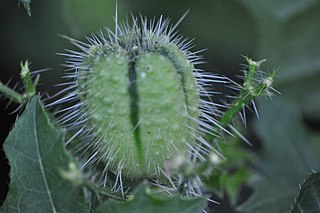
Cnidoscolus texanus, commonly known as Texas bullnettle, tread-softly, mala mujer, and finger rot, is a perennial herb covered with stinging hairs. The main stem, branches, leaves, and seed pods are all covered with hispid or glass-like bristly hairs that release an allergenic toxin upon contact. Contact with the plant results in intense pain: stinging, burning, and itching lasting for hours. It is native to the U.S. states of Texas, Arkansas, Kansas, Louisiana, and Oklahoma and also native to the northeastern state of Tamaulipas, Mexico. It is an herbaceous flowering plant that grows between 30–80 cm (11.8–31.5 in) tall and as much as 1 m (3.3 ft) across. Texas bullnettle has showy, fragrant white flowers that can bloom throughout the year in southern regions of its distribution, predominantly March to November in northern regions. It is a drought-tolerant plant, therefore making it a superb choice for xeriscaping. This plant is attractive to birds, bees, butterflies, and other insects. The seeds are known to be consumed by Rio Grande wild turkeys and mourning doves.

Cnidoscolus urens is a perennial, tropical American stinging herb of the family Euphorbiaceae, and is one of some 100 species belonging to the genus Cnidoscolus. The plant is locally known as 'bull nettle', 'spurge nettle', 'bringamosa' and 'mala mujer'.
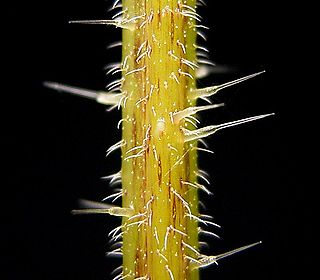
A stinging plant or a plant with stinging hairs is a plant with hairs (trichomes) on its leaves or stems that are capable of injecting substances that cause pain or irritation.

Urtica gracilis, commonly known as the slender nettle, tall nettle, or American stinging nettle, is a perennial plant plant without woody stems that is well known for the unpleasant stinging hairs on its leaves and stems. It is native to much of the North America from Guatemala northwards and temperate areas of South America. It is easily confused with the visually very similar Eurasian species Urtica dioica and is still listed in some resources as a subspecies of this plant. However, genetic analysis and experiments show that they are genetically distinct.

Boehmeria cylindrica, with common names false nettle and bog hemp, is an herb in the family Urticaceae. It is widespread in eastern North America and the Great Plains from New Brunswick to Florida to Texas to Nebraska, with scattered reports of isolated populations in New Mexico, Arizona, and Utah, as well as in Bermuda, Mexico, Central America, the West Indies, and South America.

Cnidoscolus angustidens, with the common name mala mujer, is an herbaceous perennial plant in the spurge family (Euphorbiaceae).
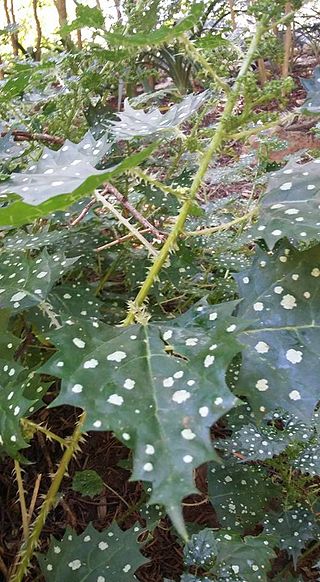
Laportea grossa, or spotted nettle, is an African plant in the family Urticaceae, and one of 31 species in the genus. This species occurs in shady places in coastal and escarpment forests, closed woodland and on streambanks from George through the Eastern Cape, KwaZulu-Natal to southern Mozambique. Young leaves of this species are cooked and eaten as a vegetable.
